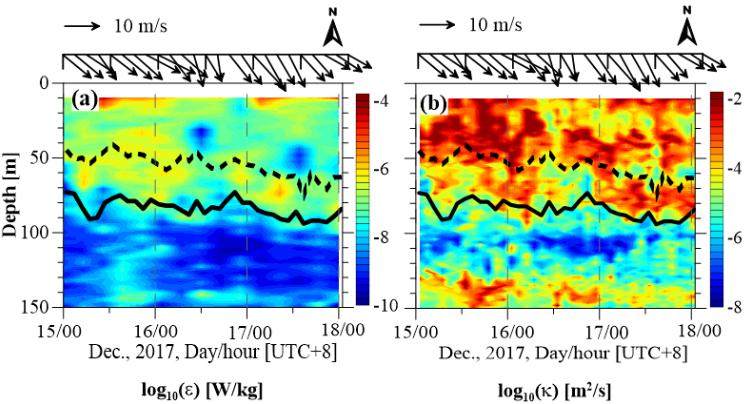The barrier layer (BL) is an expansive halocline layer commonly found in the western Equatorial Pacific, long been thought to inhibit entrainment of colder thermocline water into the surface mixed layer (ML), consequently enhancing air sea interaction.
Previous coupled model-based sensitivity studies demonstrated that the removal of BL in the warm pool by artificially enlarged diffusivity can prevent development of El Nino.
However, whether BL mixing indeed exists in the warm pool or in other regions of the Equatorial Pacific remains unrevealed.
Recently, the research team led by Prof. WANG Fan from the Institute of Oceanology of the Chinese Academy of Sciences (IOCAS) provided more information in this issue (BL mixing) in the Equatorial Pacific via both direct turbulence observations and indirect estimates based on modern data.
The study was published in Geophysical Research Letters on Feb. 24.
Researchers found frequent turbulent mixing in the BL from both direct turbulence measurements and indirect mixing estimates within an 11-year-long Argo profile dataset. The observed BL mixing is as strong as in the ML, yielding effective heat transfers across the isothermal layer (IL) base. The estimated BL mixing event is ubiquitous, with occurrence ranging 20%-60% spatially and peaking at around 160°W, 0°N.
BL mixing occurs more frequently in La Nina than El Nino years in particular; the correlation between the occurrence of BL mixing and the Oceanic Nino Index (ONI), an index for the intensity of El Nino-Southern Oscillation (ENSO), is significantly high, showing clear relationship between each other.
Additionally, the BL mixing is associated with increased mean ML, BL and IL thickness (increased by 10, 20, 25 m, respectively), decreased BL stratification and temperature (by up to 2°C), and increased salinity (by 0.2 PSU) in the IL, suggesting potential impacts and/or responses to ENSO via ENSO dynamics.
"The results have many implications, particularly for the active air-sea interactions in the Equatorial Pacific. How the BL mixing may impact the El Nino development deserves further exploration," said Prof. LIU Chuanyu, first author of the study.
The research was supported by the Strategic Priority Research Program of Chinese Academy of Sciences (CAS), the Key Research Program of Frontier Sciences of CAS, and the National Natural Science Foundation of China.

Fig. 1 the turbulent kinetic energy dissipation rate in a logarithm scale and estimated diffusivity, accompanied with wind at 140°E, 0° on the top of the panels; the thick and dashed lines denote the isothermal layer and mixed layer bases, respectively; between them is the BL.

Fig. 2 Spatial (top) and temporal (bottom) variation of the occurrence rate of BL mixing in the Equatorial Pacific (area-averaged over the box in the top panel)
Liu, C.*, Huo, D., Liu, Z., Wang, X., Guan, C., Qi, J., & Wang, F.* (2022). Turbulent mixing in the barrier layer of the Equatorial Pacific Ocean. Geophysical Research Letters. DOI: 10.1029/2021GL098690.
LIU Chuanyu
Institute of Oceanology
E-mail: chuanyu.liu@qdio.ac.cn
(Editor: ZHANG Yiyi)
|
|

Address: 7 Nanhai Road, Qingdao, Shandong 266071, China
Tel: 86-532-82898902 Fax: 86-532-82898612 E-mail: iocas@qdio.ac.cn


